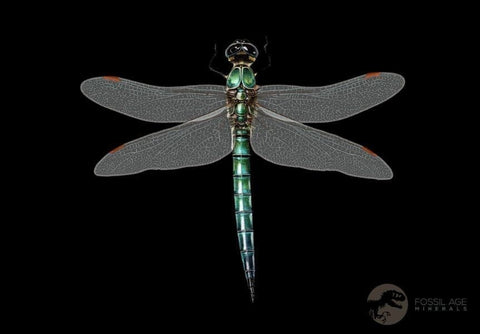0.7" Dragonfly Larvae Fossil Libellula Doris Plate Upper Miocene Piemont Italy Display
Location: Piemonte Area, Santa Vittoria d’Alba. Italy
Weight: 1.9 Ounces With Display.
Dimensions: 3.3 Inches Long, 2.5 Inches Wide, 1 Inch Thick (Display)
Dimensions: 1.9 Inches Long, 1.5 Inches Wide, 0.2 Inches Thick (Plate)
Insect Dimensions: 0.7 Inches Long, 0.6 Inches Wide
Comes with a Free White Display Box.
Comes with a Certificate of Authenticity.
The item pictured is the one you will receive.
Upper Miocene, 16 Million-Year-old
Fossil Dragonfly Larvae, Libellula Doris
The dealer from whom I acquired this insect plate. He has access to a special shale outcrop in the foothills of the Alps where he quarries them. The thin plate has three complete specimens aesthetically arranged. The detail is excellent, with eye-catching visual appeal. Libellula is a genus of extant dragonflies, commonly called Skimmers. Many of the members of this genus are brightly colored or have banded wings.
Members of the order Odonata, dragonflies, represent a distinct lineage within the insect world, characterized by their exceptional morphological adaptations. The family Libellulidae distinguishes itself through hindwings that exceed the width of forewings, providing enhanced aerodynamic capability. These insects exhibit large compound eyes offering nearly 360-degree vision, paired with two sets of robust, transparent wings and an elongated abdomen. While superficially similar to damselflies, dragonflies display a diagnostic resting posture—their wings extend laterally and perpendicular to the body rather than folding along it. Despite possessing the standard six insectoid legs, dragonflies demonstrate limited terrestrial locomotion, having evolved instead for aerial dominance. Their flight performance ranks among the most impressive in the insect kingdom, achieving velocities that few other flying organisms can match. This fossilized specimen of Libellula doris from the Upper Miocene of Piedmont, Italy, preserves the anatomical hallmarks of this ancient predatory lineage, offering paleontological evidence of morphological stability across millions of years.
Dragonflies are important predators that eat mosquitoes and other small insects, such as flies, bees, ants, wasps, and, very rarely, butterflies. They are usually found around marshes, lakes, ponds, streams, and wetlands because their larvae, known as “nymphs”, are aquatic. Some 5680 different species of dragonflies (Odonata) are known in the world today.
This exceptional fossil captures a dragonfly larva from the Upper Miocene period, preserving evidence of an organism that dominated freshwater ecosystems millions of years ago. Dragonfly naiads represent one of nature's most efficient aquatic predators, spending the majority of their lifecycle submerged while hunting invertebrates and small vertebrates with sophisticated extendable mandibles. These larvae employ a unique jet-propulsion mechanism, expelling water through their rectal chamber to achieve rapid movement. Development spans months to years depending on species, with some larger specimens requiring up to five years to reach maturity. The transition to adulthood involves a dramatic metamorphosis—the naiad climbs emergent vegetation, its exoskeleton ruptures, and the fully formed dragonfly emerges to pursue an aerial existence. Adult dragonflies demonstrate unparalleled flight capabilities, maneuvering in all directions with precision. This Libellula doris specimen from Piedmont, Italy, provides invaluable paleontological insight into the evolutionary continuity of these remarkable insects across geological time.


















